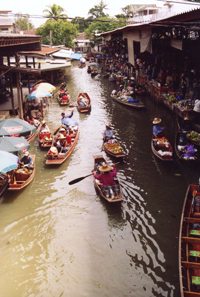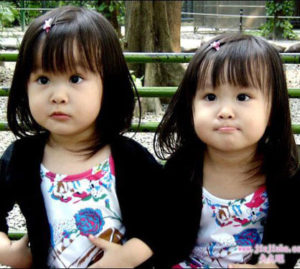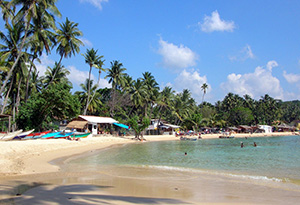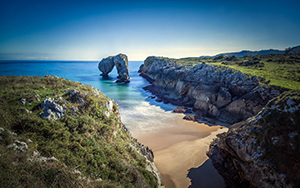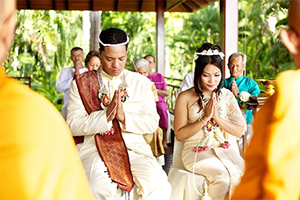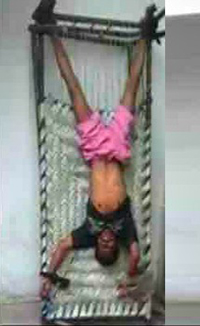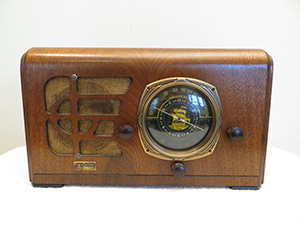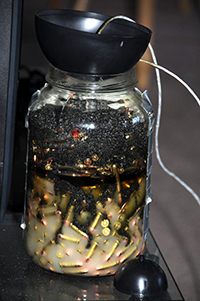How Case Derived: Past Life Memories in Childhood
Researchers: Francis Story and Ian Stevenson, MD
From: Cases of the Reincarnation Type, Volume IV, Thailand and Burma, by Ian Stevenson, MD
Article by: Walter Semkiw, MD
The Drowning Death of Chuey Puang Pei
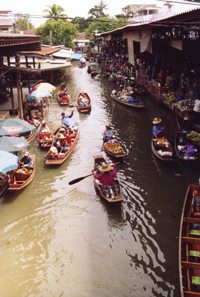 Chuey Puang Pei was born in 1946 in Thailand. His father’s name was Tai Puang Pei and his mother was Tong Bai Puang Pei. Chuey had a brother, Chuan, and a sister, Khao.
Chuey Puang Pei was born in 1946 in Thailand. His father’s name was Tai Puang Pei and his mother was Tong Bai Puang Pei. Chuey had a brother, Chuan, and a sister, Khao.
The family lived along one of the many canals or waterways that are found in the central plain of Thailand, which are called khlongs. These canals stem from major rivers in the area. Through the use of boats, khlongs serve as routes of transportation, much like the canals of Venice, Italy. Chuey lived in the village of Bang Chan, which was on a waterway of the same name, Khlong Bang Chan.
Ironically and unfortunately, though Chuey lived by a waterway, he never learned to swim. In 1950, when he was 4 years old, Chuey was on the shore of the Khlong Bang Chan with his uncle, Klah Puang Pei, and his older brother, Chuan, who was about 8 years old at the time.
Chuey and Chuan were playing in shallow water by the shore. At one point, Chuan and his uncle lost sight of Chuey. At one moment he was on the bank of the waterway and the next moment he was gone. Shortly thereafter, they found Chuey’s body in the water and as they pulled him out, they discovered that he had drowned. This tragedy was not unusual, as at the time, young children were known to perish in the klongs of Thailand fairly often.
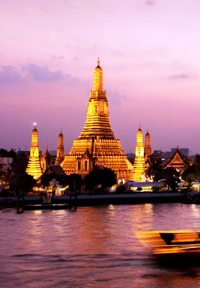 The uncle, Klah Puang Pei, said that he saw Chuan playfully pulling on Chuey’s legs before the drowning, though when questioned, Chuan denied this. Chuey’s body was taken to the wat or Buddhist temple at Khlong Bang Plee Noi, where it was cremated. As mentioned, Chuey died in 1950 at 4 years of age. His brother Chuan went on to become a Buddhist monk.
The uncle, Klah Puang Pei, said that he saw Chuan playfully pulling on Chuey’s legs before the drowning, though when questioned, Chuan denied this. Chuey’s body was taken to the wat or Buddhist temple at Khlong Bang Plee Noi, where it was cremated. As mentioned, Chuey died in 1950 at 4 years of age. His brother Chuan went on to become a Buddhist monk.
Child’s Past Life Memories: Chuey is Reborn as Ampan, a Girl, Who recalls her Past Life Name & Death by Drowning
Ampam Petcherat, a girl, was born in March 1954 in the village of Song Khlong, which is located on the waterway of the same name. Song Khlong is 15 kilometers or 9 miles from Bang Chan, the village where Chuey lived. At the time, Song Khlong could only be reached from Bang Chan by boat. Song Khlong is 37 kilometers or 23 miles from Bangkok, the capital city of Thailand.
Ampan’s father was named Yod and her mother was Kim Saum. When she learned to talk, Ampan said that Yod was not her father and that Kim Saum was not her mother, as she had another mother. Ampan also said she had a previous brother who was going to become a monk.
Ampan’s parents separated when she was a child. Ampan and her mother, Kim Saum, moved 7 kilometers, or a little over 4 miles, north to the village of Khlong Darn. When she was one year old, Ampan told her mother that she had another mother and father at Klong Bang Chan. She said that she was a boy before and described her house. She cried when she talked about her previous home and said that she wanted to be taken there. She said she died by drowning after being bitten by a snake. Ampan repeated this story regarding a previous life from time to time. She said that in her prior lifetime, her name was Chuey.
Past Life Memory: Ampan Recognizes her Past Life Village and Aunt
Each year at harvest time, Kim Saum would paddle by boat to sell produce in the area of Khlong Bang Chan. When Ampan was one and a half years of age, Kim Saum took her on one of these trips. Ampan recognized the area and said that this was where she had lived before as a boy.
When Ampan was 7 years old, she spontaneously recognized a woman who was walking in Khlong Darn, the village where Ampan and her mother lived. Ampan told this woman that she was her aunt. As the woman had never met Ampan and her mother before, she paid no attention to Ampan.
On a second occasion, Ampan saw the same woman and addressed her as “my aunt.” This time the woman stopped and asked Ampan how she knew her. Ampan responded, “You are my mother’s older sister.” Ampan embraced the woman and asked to be taken to her previous family. This woman was Joy Ruang Gun, who was indeed Chuey’s maternal aunt.
Ampan Recalls the Names of her Past Life Parents, Details of her Past Life Home and Place of Cremation
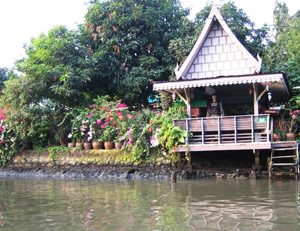 Joy then asked, “Who are your parents?” Ampan replied that that her father’s name was Tai and that her mother’s name was Bai. Recall that Chuey’s father’s name was Tai Puang Pei and that his mother was Tong Bai Puang Pei.
Joy then asked, “Who are your parents?” Ampan replied that that her father’s name was Tai and that her mother’s name was Bai. Recall that Chuey’s father’s name was Tai Puang Pei and that his mother was Tong Bai Puang Pei.
Ampan went on and said that at her prior home, there was a bamboo tree in front of the house and that there were 2 red jars at the house. She said that there were 2 red dogs and 3 buffaloes at her prior home. Regarding her death in the prior lifetime, Ampan said that she was playing in the water when she fell into the water and drowned. She said that her father took her body to the Wat Bang Plee for cremation (the full name of the temple is Wat Bang Plee Noi).
As all these statements were correct for the lifetime of Cheuy, Joy decided to take Ampan and her mother to meet Cheuy’s family.
At her Past Life Home, Ampan recognizes her Past Life Parents, Sister and Place of Drowning
When Ampan was taken to Khlong Bang Chan and her past life family’s home, she went to Tong Bai, Chuey’s mother, embraced her tightly and said “mother.” Chuey’s father was not at home initially, but Tai returned shortly thereafter in a boat with two other men. While they were still in the vessel at the boat landing, Ampan was asked to identify her previous father. Though attempts were made to mislead her, Ampan correctly identified Tai as her past life father.
When Ampan saw Khoa, she pointed at her and said, “Sister.” Khoa was Chuey’s sister.
In surveying the property where Chuey’s family lived, Ampan noted that there used to be banana and coconut trees. She also said that there used to be two houses, rather than just one. Ampan was right, as when Chuey was alive, the banana and coconut trees were there, but removed after his death. Similarly, one of the structures that had been on the property had been removed, but was present during Chuey’s time. Ian Stevenson was impressed that Ampan made these accurate statements regarding items that were no longer there.
Ampan also correctly pointed out the location near the house where she, as Chuey, had drowned.
Past Life Memories: At the Temple, Ampan Identifies her Past Life Brother, Cousin & Friend
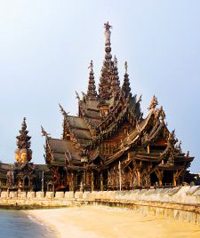 After being taken to her past life home, Ampan was taken to the temple, or wat, at Bang Plee Noi where Chuey was cremated and where Chuan, Chuey’s brother, was now living as a monk. At the temple, Ampan recognized, among a group of a dozen or more monks, Chuan. Ampan correctly pointed out Chaun as her brother in her prior lifetime. Both Chuan and Ampan wept at this reunion.
After being taken to her past life home, Ampan was taken to the temple, or wat, at Bang Plee Noi where Chuey was cremated and where Chuan, Chuey’s brother, was now living as a monk. At the temple, Ampan recognized, among a group of a dozen or more monks, Chuan. Ampan correctly pointed out Chaun as her brother in her prior lifetime. Both Chuan and Ampan wept at this reunion.
Another monk in the group was one of Chuey’s cousins. Ampan also correctly identified this monk, Sa Ing, as one of her past life cousins. She pointed to another young monk, named Sak, who was seated among the group and said, “This monk is the son of Nang Pad.” Chuey was acquainted with this individual and Ampan’s statement that Sak was the son of Nang Pad was accurate.
Ampan’s Account of Drowning & Past Life Phobia of Snakes
 There was a discrepancy between Ampan’s account of how she had drowned in her prior incarnation and the version known by Chuey’s parents. According to Ampan’s memory, Chuey had been playing with Chuan in shallow water near the shore. Ampan said Chuan was pulling on Chuey’s legs, which was observed by Chuey’s uncle, Klah Puang Pei. Ampan said that Chuey was then bitten by a snake on the right leg, fell into the water and drowned. Chuey’s family had no knowledge of Chuey being bitten by a snake prior to drowning.
There was a discrepancy between Ampan’s account of how she had drowned in her prior incarnation and the version known by Chuey’s parents. According to Ampan’s memory, Chuey had been playing with Chuan in shallow water near the shore. Ampan said Chuan was pulling on Chuey’s legs, which was observed by Chuey’s uncle, Klah Puang Pei. Ampan said that Chuey was then bitten by a snake on the right leg, fell into the water and drowned. Chuey’s family had no knowledge of Chuey being bitten by a snake prior to drowning.
Ian Stevenson noted that there are many water snakes that inhabit Thai waterways or khlongs, and that some inflict fatal bites that do not cause significant swelling. As such, Stevenson reasoned, Chuey could have been bitten by a snake without his brother or uncle noticing the snake or a snake bite.
Stevenson questioned whether there would have been enough time for venom from a snake bite to take effect. Recall that Chuey was present on the shore at one moment, suddenly disappeared and was then found dead in the water. Stevenson hypothesized that Cheuy may have simply been startled by the sight of a snake in the klong and in attempting to flee, slipped into the water, which led to his drowning.
Ampan had a severe phobia of snakes, presumably due to her memories of being bitten or startled by a snake in the water, which led to her drowning death as Chuey.
Ampan Scolds Chuan for Causing Her Past Life Death as Chuey
Ampan also insisted that one of the series of events that had led to his drowning was Chuan pulling at his legs in the water. As noted, Chuey’s uncle, Klah Puang Pei, had reported that Chuan was pulling at Chuey’s legs before he disappeared. Chuan, as an 8 year old, denied this claim, perhaps out of fear that he would be blamed for Chuey’s death. Of interest, when Ampan recognized Chuan at the temple where he was living as a monk, after they embraced and wept together, Ampan chastised Chuan for causing her drowning as Chuey.
Of interest, Ampan had a phobia of snakes, though she did not have a fear of water.
Ampan’s Experience of Heaven
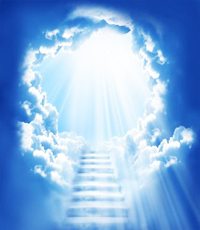 When Ian Stevenson met with Ampan in 1966, he asked if she remembered what happened in the period between Chuey’s death in 1950 and her birth in 1954. Ampan said that after Chuey drowned and his body was cremated, a man, who we will call the first man, took him to another place where other dead persons were located and introduced him to the “head man.” Then he, Chuey, went with a second man who escorted him to heaven. In heaven, he met a third man of large size and black complexion who was dressed in white and who he remembered was kind. The second man then took him back to the first man. Ampan said she, or he as Chuey, was then given a piece of fruit. When she ate the fruit, she was reborn.
When Ian Stevenson met with Ampan in 1966, he asked if she remembered what happened in the period between Chuey’s death in 1950 and her birth in 1954. Ampan said that after Chuey drowned and his body was cremated, a man, who we will call the first man, took him to another place where other dead persons were located and introduced him to the “head man.” Then he, Chuey, went with a second man who escorted him to heaven. In heaven, he met a third man of large size and black complexion who was dressed in white and who he remembered was kind. The second man then took him back to the first man. Ampan said she, or he as Chuey, was then given a piece of fruit. When she ate the fruit, she was reborn.
Reincarnation and Change in Gender: Ampan Acts as if She is Still a Boy
Ampan, when young, had definite masculine traits, which seem to reflect her past lifetime as Chuey, a male. Ampan’s mother said that she liked to dress like a boy, including wearing pants instead of a skirt. Ampan also engaged in boy’s sports, such as boxing. In 1968, when Ampan was 14, she told Ian Stevenson that she would prefer to be a boy as men have freer lives. Stevenson noted that Ampan walked with a masculine gait. A year later, in 1969, Ampan still did boxing, still wished she was a boy and had little romantic interest in boys, which is unusual for a teenage girl.
Reincarnation & Homosexuality, Lesbianism, Transsexualism & Gender Identity Issues
Ampan’s wish to be a man, which appears to be related to her past incarnation as a male, has prominent similarities to: The Reincarnation Case of a Japanese Soldier | Ma Tin Aung Myo
In this Ian Stevenson reincarnation study, a male Japanese soldier serving in Burma during World War II died, reincarnated as a Burmese woman named Ma, but maintained masculine traits and was attracted to women. Ma became a lesbian. This case shows how reincarnation can bring insight in understanding homosexuality, lesbianism, bisexuality, transsexualism, transgender and gender identity issues.
In Ian Stevenson’s series of approximately 1200 validated reincarnation cases in which young children spontaneously remembered their past lives, in only 10 percent of cases did the soul change gender. It may be that if a soul is accustomed to incarnating into a particular gender and then reincarnates into the opposite sex, gender identity issues may arise.
In contrast to the Japanese Soldier | Ma reincarnation case, Ampan eventually married a US male soldier who was stationed in Thailand. The couple later moved to California.
Principles of Reincarnation & Understanding Past Lives
Phobia from a Past Lifetime: Ampan demonstrated a phobia of snakes, apparently due to her memories of being bitten or startled by a water snake, which led to her drowning.
Gender Change: Chuey, a boy, reincarnated as Ampan, a girl. As a child and teenager, Ampan insisted on wearing boy’s clothing, she participated men’s sports such as boxing and she walked like a boy. Ampan told Ian Stevenson that she wished that she were a boy. Though she demonstrated these gender identity issues when young, she eventually married a man.
Spirit Beings in Reincarnation Cases: Ampan, as a spirit being, described her experience of heaven.
Relationships Renewed through Reincarnation: Ampan was reunited with her past life family.
